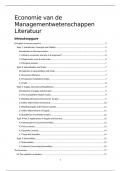Summary
Summary: Literature & Economics of Sciences
- Course
- Institution
This document contains an overview of all the literature you need to read for the Economics of Management Sciences course at Radboud University. It is a summary of parts of the (online) books “Principles of microeconomics”, “The Economy 1.0” and “Economy, Society and Public Policy”. It...
[Show more]



